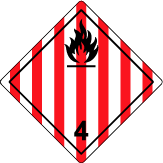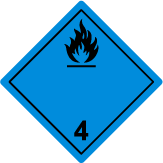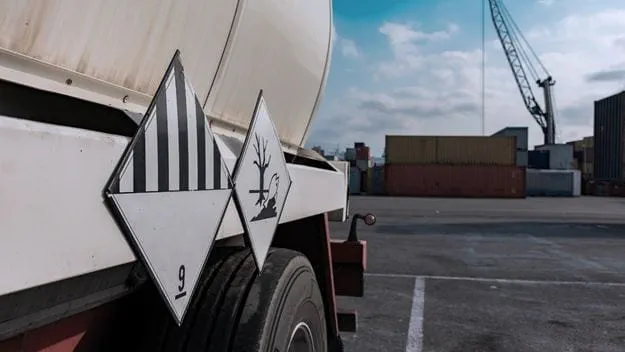Substances and Articles of Class 4, have been assigned to one of 3 sub-classes.

Hazard class 4.1: Flammable solids, self-reactive substances, polymerizing substances and solid desensitized explosives
Flammable solids are readily combustible solids and solids which may cause fire through friction. Readily combustible solids are powdered, granular, or pasty substances which are dangerous if they can be easily ignited by brief contact with an ignition source, such as a burning match, and if the flame spreads rapidly. The danger may come not only from the fire but also from toxic combustion products. Metal powders are especially dangerous because of the difficulty of extinguishing a fire since normal extinguishing agents such as carbon dioxide or water can increase the hazard.
Self-reactive substances are thermally unstable substances liable to undergo a strongly exothermic decomposition even without participation of oxygen (air).
Polymerizing substances are substances which, without stabilization, are liable to undergo a strongly exothermic reaction resulting in the formation of larger molecules or resulting in the formation of polymers under conditions normally encountered in carriage.
Self-reactive substances are thermally unstable substances liable to undergo a strongly exothermic decomposition even without participation of oxygen (air).
Polymerizing substances are substances which, without stabilization, are liable to undergo a strongly exothermic reaction resulting in the formation of larger molecules or resulting in the formation of polymers under conditions normally encountered in carriage.

Hazard class 4.2: Substances liable to spontaneous combustion
Pyrophoric substances are substances, including mixtures and solutions (liquid or solid), which even in small quantities ignite on contact with air within five minutes, and self-heating substances and articles which are substances and articles, including mixtures and solutions, which, on contact with air, without energy supply, are liable to self-heating. These substances will ignite only in large amounts (kilograms) and after long periods of time (hours or days).

Hazard class 4.3: Substances which, in contact with water, emit flammable gases
Class 4.3 are substances which react with water to emit flammable gases liable to form explosive mixtures with air. They are easily ignited by all ordinary sources of ignition that produce a spark. They are often referred to as 'dangerous when wet'.
Packing groups
Classes 4.1, 4.2 and 4.3 have been assigned a packing group which indicates the degree of danger.Packing Group I: Substances presenting high danger
Packing Group II: Substances presenting medium danger
Packing Group III: Substances presenting low danger
Examples of commonly transported Class 4.1 / 4.2 / 4.3 dangerous goods
Alkali metals, metal powders, firelighters, matches, calcium carbide, camphor, celluloid, desensitized explosives, nitrocellulose, phosphorus, sulphur.You may also be interested in
Any questions?
Our experts are ready to help. Get in touch and we'll find the solution you need.




